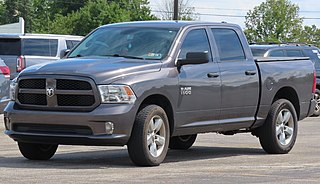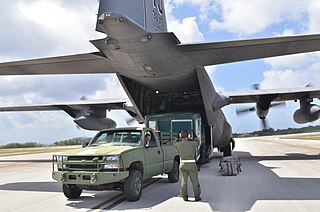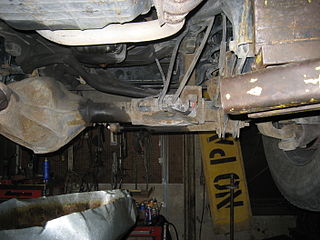
The Ram pickup is a full-size pickup truck manufactured by Stellantis North America and marketed from 2010 onwards under the Ram Trucks brand. The current fifth-generation Ram debuted at the 2018 North American International Auto Show in Detroit, Michigan, in January of that year.

The Dodge Power Wagon is a four-wheel drive medium duty truck that was produced in various model series from 1945 to 1980 by Dodge. The Power Wagon name was revived for the 2005 model year as a four-wheel drive version of the Dodge Ram 2500. As a nameplate, "Power Wagon" continues as a special package of the four-wheel drive version of 3/4 ton Ram Trucks 2500 model.

TorqueFlite is the trademarked name of Chrysler Corporation's automatic transmissions, starting with the three-speed unit introduced late in the 1956 model year as a successor to Chrysler's two-speed PowerFlite. In the 1990s, the TorqueFlite name was dropped in favor of alphanumeric designations, although the latest Chrysler eight-speed automatic transmission has revived the name.
The TREMEC TR-4050 is a 5-speed manual transmission for longitudinal engine rear wheel drive trucks. It includes one overdrive gear and a light-weight aluminum housing. It is manufactured by Transmission Technologies Corporation. New 4wd TR-4050 units are currently available in the United States through any Authorized Tremec Distributor.
Jeep uses a variety of four-wheel drive systems on their vehicles. These range from basic part-time systems that require the driver to move a control lever to send power to four wheels, to permanent four-wheel systems that monitor and sense traction needs at all four wheels automatically under all conditions.

The Jeep Cherokee (XJ) is a sport utility vehicle manufactured and marketed across a single generation by Jeep in the United States from 1983 through 2001 — and globally through 2014. It was available in two- or four-door, five-passenger, front-engine, rear- or four-wheel drive configurations.
The New Venture Gear 3500, commonly called NV3500, is a 5-speed overdrive manual transmission manufactured by New Venture Gear and used by GM and Dodge in compact and full-size light trucks.
It can be identified by its two-piece aluminum case with integrated bell housing and top-mounted tower shifter.
The New Venture Gear 4500, colloquially known as NV4500, is a 5-speed manual transmission manufactured by New Venture Gear and used in General Motors and Chrysler products from 1991 to 2007.
Vehicles made by American Motors Corporation (AMC) and Jeep incorporated a variety of transmissions and transfer case systems. This article covers transmissions used in the following vehicle models and years:

The Commercial Utility Cargo Vehicle (CUCV) is a vehicle program instituted to provide the United States military with light utility vehicles based on civilian trucks.

The Dana/Spicer Model 60 is an automotive axle manufactured by Dana Holding Corporation and used in OEM pickup and limited passenger car applications by Chevrolet, Dodge, Chrysler, Jeep, Ford and Land Rover. There are front and rear versions of the Dana 60. It can be readily identified by its straight axle tubes, 10 bolt asymmetrical cover, and a "60" cast into the housing. Gross axle weight ratings are often lowered by the vehicle manufacturer for safety and tire reasons. They are also lowered to reduce loads on other powertrain components such as transmissions and transfer cases. Dana 60 Axles are also increasingly swapped into many custom offroad applications to accommodate larger tires and deep compound gearing with locking differentials.
The Dana/Spicer Model 70 is an automotive axle manufactured by Dana Holding Corporation and has been used in OEM heavy duty applications by Chevrolet, Dodge, and Ford. It can be identified by its straight axle tubes, 10 bolt asymmetrical cover, and a "70" cast in to the housing and is visually similar to the Dana 60. The majority of the Dana 70s are rear axles, however Dana 70 front axles do exist. Both front and rear axle variations were first offered in 1957. The Dana 70 is generally regarded to have more strength than a Dana 60 but not as much as a Dana 80. Gross axle weight ratings are often lowered by the vehicle manufacturer for safety and tire reasons.

The Dana/Spicer Model 80 is an automotive axle manufactured by Dana Holding Corporation and has been used in OEM heavy duty applications by Chevrolet, Dodge, and Ford. It can be identified by its straight axle tubes, 10 bolt asymmetrical cover, and a "80" cast into the housing. Dana 80's are made as full floating, rear axles only and are step up in overall strength compared to the Dana 70. 1988 Ford was the first company to use the Dana 80. The Dana 80 has a GAWR up to 11,000 pounds (5,000 kg), however it is common practice among manufacturers to derate Dana 80's. Gross axle weight ratings are lowered by the vehicle manufacturer for safety and tire reasons. The OEM Limited slip differential originally was a "Power Lok" until 1998 when the "Trac Lok" phased it out. Trac Loks were a $350.00 USD option with Ford Super Duty trucks. The Dana 80 Trac Lok is unique being it is a 4 pinion unit, unlike other Dana Trac Lok units with 2 pinions. This was the only rear axle available for the 2nd generation Dodge Ram 3500 trucks.

The Dana/Spicer Model 50 was an automotive axle manufactured by the Dana Holding Corporation for 25 years and was used solely in OEM Ford applications. Dana 50's were made as front axles only until it was revived in rear solid axle configuration in the 2022 Ford Bronco Raptor. The Dana 50 has a "50" cast into the housing and is regarded to have more strength than a Dana 44, but not as much as a Dana 60. It was only produced in a reverse cut gear set aka a high pinion.

A center axle disconnect system or CAD is an alternative to locking hubs. CAD systems are typically used in front drive axles on four wheel drive vehicles. A CAD system works by having an axle shaft split into two pieces. One piece is connected to the carrier, the other connected to the wheel. This reduces drag on the axle by allowing only the spider and side gears to spin, while the differential carrier, pinion and drive shaft are at rest. The axle is engaged by connecting the two split axle shafts. The ends of the axles are typically splined and use a collar to connect the two shafts together by sliding over both shafts.

The Dana/Spicer Model 35 is an automotive axle. It has been manufactured by Dana Holding Corporation since 1985 when American Motors (AMC) sold its axle tooling equipment to Dana. The axle was named AMC-15 when it was first made in 1962. Dana upgraded the axle, and added IFS and Twin Traction Beam front axle variations.

The Sterling 10.5 axle is an automotive axle manufactured by Ford Motor Company at the Sterling Axle Plant in Sterling Heights, MI. It was first used in model year 1985 Ford trucks. The axle was developed to replace the Dana 60 and Dana 70. The Sterling 10.5 axle is currently only made as a full floating axle.
The Ford 9-inch is an automobile axle manufactured by Ford Motor Company. It is known as one of the most popular axles in automotive history. It was introduced in 1957 model year cars and ended production in 1986, having been phased out in favor of the Ford 8.8 inch axle. However, aftermarket companies still produce the 9-inch design. It is a semi-floating drop-out axle and had a GAWR up to 3,600 lb (1,630 kg).
The Ford 8.8 is an automotive axle manufactured by Ford Motor Company at the Sterling Axle Plant in Sterling Heights, MI. It was first used in model year 1983 Ford trucks. The axle was developed to replace the Ford 9-inch axle. This axle is still in production today for a variety of Ford vehicles.

The Saginaw 9.5-inch axle is an automotive axle manufactured by American Axle & Manufacturing, Inc. This differential has three major variants. A rear solid axle, a front solid axle and independent front suspension. General Motor's Saginaw Division started production of this axle in the late 1970s and all three variations are still in production today. The maximum GAWR for this axle is 6000 pounds.














